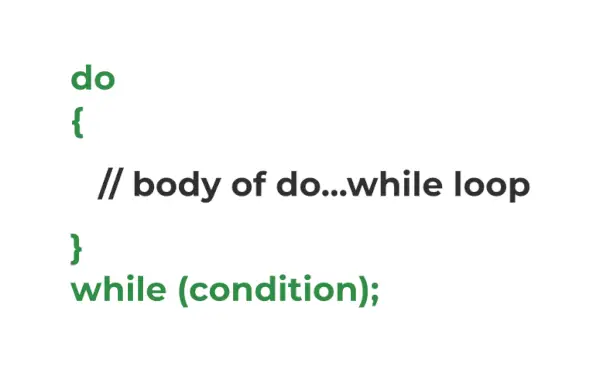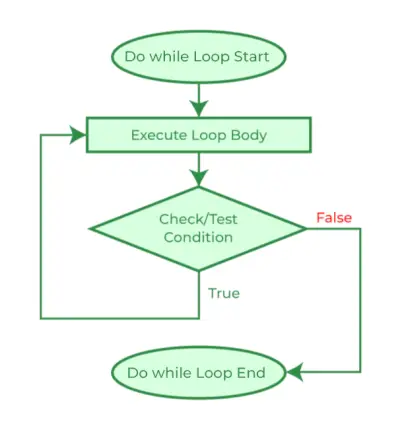Smyčky v jazyce C jsou příkazy řídicího toku, které se používají k opakování některé části kódu, dokud není splněna daná podmínka. The smyčka do-while je jedním ze tří příkazů smyčky v C, ostatní jsou smyčka while a smyčka for. Používá se hlavně k procházení polí, vektorů a dalších datových struktur.
Co je dělat... zatímco smyčka v C?
The dělat... zatímco v C je příkaz smyčky používaný k opakování některé části kódu, dokud není splněna daná podmínka. Je to forma an výstupní řízená nebo dodatečně testovaná smyčka kde se po provedení těla smyčky kontroluje podmínka testu. Díky tomu budou příkazy v cyklu do...while vždy provedeny alespoň jednou bez ohledu na to, jaká je podmínka.
Syntaxe do...while Loop v C
do { // body of do-while loop } while ( condition );> Jak používat do...při opakování v C
Následující příklad ukazuje použití smyčky do...while v programovacím jazyce C.
C
// C Program to demonstrate the use of do...while loop> #include> int> main()> {> >// loop variable declaration and initialization> >int> i = 0;> >// do while loop> >do> {> >printf>(>'Geeks
'>);> >i++;> >}>while> (i <3);> >return> 0;> }> |
>
>Výstup
Geeks Geeks Geeks>
Jak funguje... zatímco smyčka funguje?

Syntaxe Struktura cyklu do while
Fungování smyčky do...while je vysvětleno níže:
- Když ovládání programu poprvé přejde do smyčky do...while, nejprve se provede tělo smyčky a poté se zkontroluje testovací podmínka/výraz , na rozdíl od jiných smyček, kde se nejprve kontroluje podmínka testu. Díky této vlastnosti se smyčka do...while nazývá také smyčka řízená ukončením nebo smyčka dodatečně testovaná.
- Když je testovací podmínka vyhodnocena jako skutečný , řízení programu se spustí smyčky a tělo se provede ještě jednou.
- Výše uvedený proces se opakuje, dokud není testovací podmínka pravdivá.
- Když je testovací podmínka vyhodnocena jako Nepravdivé, ovládací prvky programu přejdou na další příkazy po smyčce do...while.
Stejně jako u smyčky while v C není inicializace a aktualizace součástí syntaxe smyčky do...while. Musíme to udělat explicitně před a ve smyčce.
Vývojový diagram níže ukazuje vizuální znázornění toku smyčky do... while v C.
C do... zatímco smyčkový vývojový diagram

Vývojový diagram toho, co... zatímco smyčka v C
Vnořeno do... zatímco smyčka v C
Stejně jako u jiných smyček můžeme také vnořit jednu smyčku do...while do další smyčky. Je to demonstrováno pomocí následujícího programu C.
Příklad Nested do...while Loop v C:
C
// C Program to demonstrate the nesting of do...while loop> #include> int> main()> {> >// declaring loop variables> >int> i = 0, j;> >int> count = 0;> >// outer loop starts> >do> {> >j = 0;> >// inner loop starts> >do> {> >printf>(>'%d '>, count++);> >j++;> >}>while> (j <3);> >// inner loop ends> >printf>(>'
'>);> >i++;> >}>while> (i <3);> >// outer loop ends> >return> 0;> }> |
>
>Výstup
0 1 2 3 4 5 6 7 8>
Další informace o vnořených smyčkách v C naleznete v tomto článku – Vnořené smyčky v C s příklady
Příklady do...while Loop v C
Příklad 1. C Program pro demonstraci chování smyčky do...while, pokud je podmínka od začátku nepravdivá.
C
ruční testování
// C Program to demonstrate the do...while loop behaviour> // when the condition is false from the start> #include> #include> int> main()> {> >// declaring a false variable> >bool> condition =>false>;> >do> {> >printf>(>'This is loop body.'>);> >}>while> (condition);>// false condition> >return> 0;> }> |
>
>Výstup
This is loop body.>
Jak vidíme, i když je podmínka na začátku nepravdivá, tělo smyčky se provede jednou. Je to proto, že ve smyčce do...while je podmínka kontrolována po průchodu tělem, takže když je kontrola na začátku,
- Prochází tělem smyčky.
- Provede všechny příkazy v těle.
- Zkontroluje podmínku, která se ukáže jako chybná.
- Poté smyčku opustí.
Příklad 2. C Program pro tisk tabulky násobení N pomocí smyčky do...while
Následující příklad ukazuje použití smyčky do...while pro tisk tabulky násobení N.
C
// C Program to print multiplication table using do...while> // loop> #include> int> main()> {> >int> N = 5, i = 1;> >do> {> >printf>(>'%d x %d = %d
'>, N, i, N * i);> >}>while> (i++ <10);> >return> 0;> }> |
>
apurva padgaonkar
>Výstup
5 x 1 = 5 5 x 2 = 10 5 x 3 = 15 5 x 4 = 20 5 x 5 = 25 5 x 6 = 30 5 x 7 = 35 5 x 8 = 40 5 x 9 = 45 5 x 10 = 50>
Rozdíl mezi while a do...while Loop v C
V následující tabulce jsou uvedeny ty důležité rozdíly mezi smyčkou while a do...while v C.
| zatímco Loop | dělat...zatímco smyčka |
|---|---|
| Kontroluje se zkušební stav před provedením těla smyčky. | Kontroluje se zkušební stav po popravě těla. |
| Když je podmínka nepravdivá, tělo není provedeno Ani jednou. | Tělo smyčka do...while se provede alespoň jednou i když je podmínka nepravdivá. |
| Jedná se o typ předem testovaná nebo vstupní řízená smyčka. | Jedná se o typ dodatečně testovaná nebo výstupní řízená smyčka. |
| Středník není vyžadován. | Na konci je vyžadován středník. |
Chcete-li se dozvědět více o těchto rozdílech, přečtěte si tento článek – Rozdíl mezi smyčkou while a do-while v C, C++, Java
Závěr
Závěrem lze říci, že použití jediné smyčky řízené ukončením v C, smyčky do… while, je také k iteraci konkrétní části kódu, ale způsob, jakým funguje, ji odlišuje od cyklů řízených vstupem, jako jsou smyčky while a for smyčka. Je to užitečné v případech, kdy potřebujeme provést příkaz uvnitř těla smyčky alespoň jednou, například při procházení kruhových propojených seznamů.
Často kladené otázky o C do...while Loops
1. Kolik typů smyček je v C?
roky: V jazyce C existují 3 typy smyček:
- pro Loop
- zatímco Loop
- dělat...zatímco smyčka
2. Jaké jsou vstupní řízené nebo předem testované smyčky?
roky: Vstupem řízené smyčky nebo předem testované smyčky jsou smyčky, ve kterých smyčka stav je zkontrolován před provedením těla smyčky.
3. Jaké jsou výstupní řízené nebo dodatečně testované smyčky?
roky: Výstupní řízené smyčky nebo dodatečně testované smyčky jsou smyčky, ve kterých je řízení programu přichází do těla smyčky před kontrolou stavu smyčky .
4. Která smyčka se zaručeně vykoná alespoň jednou?
roky: The do...během smyčky je zaručeno, že provede příkazy v těle smyčky alespoň jednou, protože se jedná o typ smyčky řízené ukončením.
5. Můžeme přeskočit složené závorky v syntaxi cyklu C do...while, pokud je v těle pouze jeden příkaz?
Odpověď: Ne. , nemůžeme přeskočit složené závorky v syntaxi jazyka C do...while, i když existuje pouze jeden příkaz na rozdíl od cyklu while a for.
6. Jak vytvořit nekonečnou smyčku v C pomocí smyčky do...while?
roky: Můžeme vytvořit nekonečnou smyčku v C zadáním a stav, který bude vždy pravdivý jako podmínka smyčky. Níže uvedený program ukazuje, jak na to:
C
// C Program to create a infinite loop using do...while loop> // in C> #include> int> main()> {> >// infinite loop> >do> {> >printf>(>'gfg '>);> >}>while> (1);>// always 1 ~ true> >return> 0;> }> |
>
>
Výstup
gfg gfg gfg gfg gfg gfg gfg .... (infinite)>
